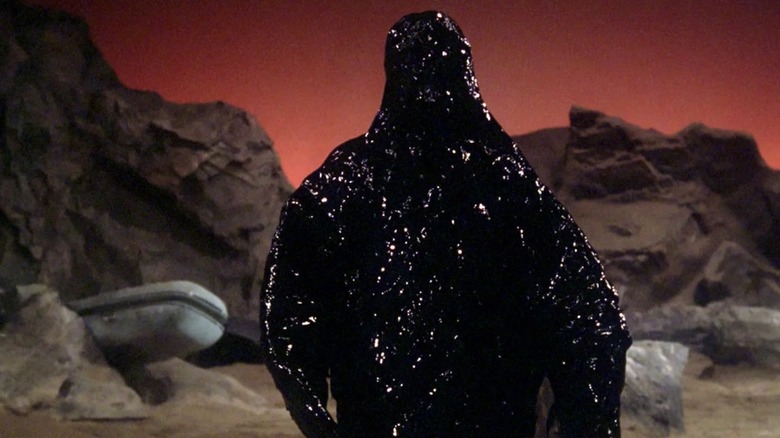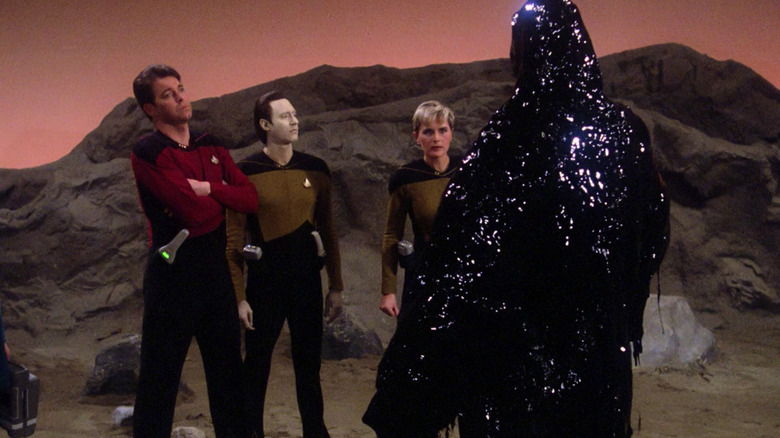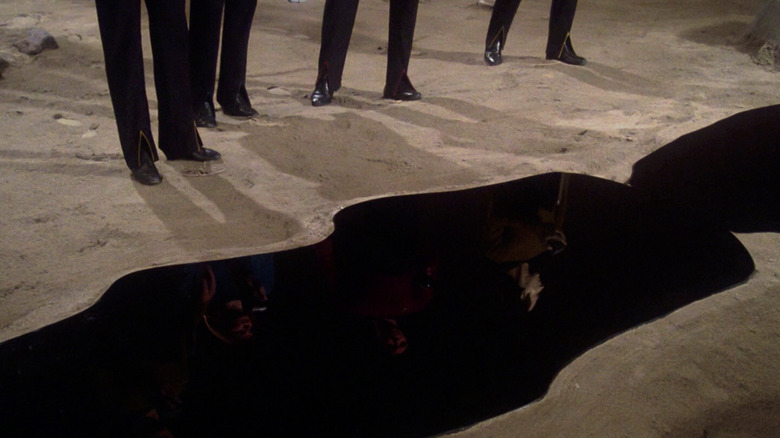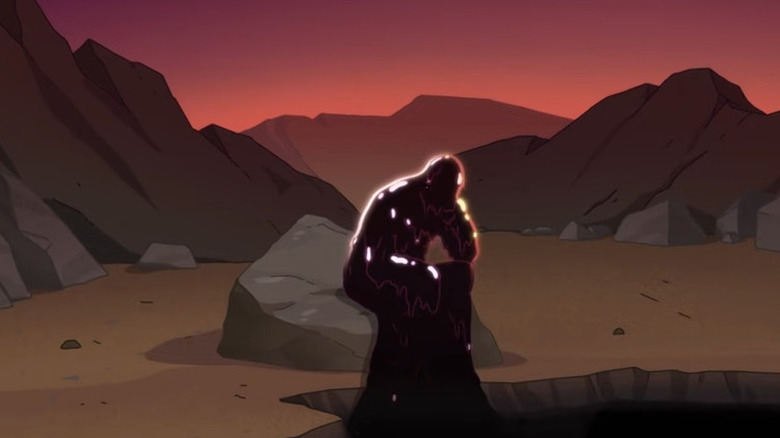The Legacy Of Armus, Star Trek's Cheapest, Scariest, Most Controversial Villain
In the first-season "Star Trek: The Next Generation" episode "Skin of Evil" (April 28, 1988), the shuttlecraft carrying Deanna Troi (Marina Sirtis) crashes on a seemingly uninhabited alien world called Vagra II. The Enterprise goes to rescue her, but finds that Troi's crashed shuttle is being guarded by a mysterious living puddle of black tar. The tar shapeshifts into a vaguely human form and calls itself Armus (Mart McChesney, voice by Ron Gans), the only inhabitant of this world. Armus is seethingly cruel and takes pleasure in the death and suffering of the people it encounters. It refuses to let Troi go, wanting to torment the Enterprise crew members who have beamed down to gather her.
In one of the most notorious moments in "Star Trek" history, Lieutenant Tasha Yar (Denise Crosby) attempts to walk around Armus, and it zaps her with a mysterious psychic blast. Yar is thrown several feet through the air, severely injured. She is beamed back on board and almost immediately pronounced dead. Yar's quick and incidental death is one of the series' more abrupt and shocking scenes.
Yar was given a touching funeral scene at the end of the episode, but many Trekkies, even to this day, feel that Yar's death was jarring and lacked respect. She was merely murdered by a monster-of-the-week. A monster, incidentally, that wouldn't return to the series until the "Star Trek: Lower Decks" episode "The Spy Humongous" (September 16, 2021).
Armus, many also feel, looked absurd. The creature looks more or less like a garbage bag covered in maple syrup. As it so happens, as explained in the 1993 book "Star Trek: The Next Generation: Make-Up FX Journal," the "tar" used to visually realize Armus was made of Metamucil mixed with black printer's ink.
What is Armus made of?
The origin of Armus is mythical in a Jack Kirby sort of way. The "tar" is the physical manifestation of all the negative emotions and psychic impulses of a long-forgotten species of unnamed "Titans" who used advanced technology to literally rid themselves of hate. The Titans then left their world and abandoned their sticky, tar-like hatred. Over the years — centuries? millennia? — Armus evolved from that hate into an intelligent being. Armus is, like Changelings, a living liquid and has no internal organs or skeleton. It can move around and alter its density at will, and also clearly possesses advanced, terrifying psychic powers. Its powers also involved a far-reaching psychic field, which was why the Enterprise couldn't beam Troi to safety.
Armus isn't harmed by phasers, and, at one point, sucks Commander Riker (Jonathan Frakes) into its body. While inside, Riker is seemingly reduced to a liquid state wherein he is savagely tortured. Armus then reconstitutes Riker and spits him back onto the desert floor of Vagra II. At a convention attended by this author, Frakes admitted that he actually had to climb into a pool of ink-black Metamucil, an unpleasant experience to say the least. This story, however, was contradicted by the "FX Journal" which stated that Frakes' stuntman was used for the submersion scene.
As a being of pure anger, Armus didn't behave entirely logically. It had been alone on Vagra II for God knows how long, waiting for torture victims to stumble into its path. When victims did appear, however, Armus did everything in its power to frighten them and scare them off. It longed for company, but only required that company in order to alienate them. In short, Armus was your average Twitter user.
The existential loneliness of Armus
At the end of "Skin of Evil," Captain Picard (Patrick Stewart) was able to mock and distract Armus long enough to beam Troi (and the shuttle pilot) back onboard the Enterprise and flee. Picard knew at that point that Armus, more than anything, required people nearby in order to sate its fathomless bloodlust. Troi realized this as well, stating out loud to Armus that it was, more than anything, unutterably lonely.
The latex costumes for Armus had to be used multiple times over the course of a four-day shoot, and the Metamucil mixture broke down the rubbers in their materials. Actor McChesney was lowered into the pool of glop multiple times during filming (sans oxygen tanks), and his suits developed huge rips. He eventually had to do scenes with his back exposed. The headpiece, curiously, remained intact.
McChesney passed away in 1999 of complications related to AIDS. He was an AIDS activist for years prior. Gans, meanwhile, was a longtime voice acting veteran, having appeared in multiple B-movies since the 1950s and played Eeyore in "The House on Pooh Corner." He passed away in 2010 at the age of 78.
Perhaps with a bigger budget and more time to film, Armus would have emerged as a greater, more ancient threat. The idea of a being consisting of an entire species' negative emotions could have felt enormous and antediluvian. Like an ancient, bitter god lashing out against his long-dead creators, Armus resented existence. The character possesses an existential element that "Star Trek" didn't have the time to delve into properly; imagine a Sartre-like treatise on existential nausea! On a 1988 TV budget, however, Armus was slight, even silly.
Indeed, on "Lower Decks," the characters deigned to mock the character to his face.
A big bag of crap
At the end of "The Spy Humongous," the four main characters — a team of less-than-professional ensigns — lucked into possession of a widget called a submanifold casting stone that allowed them to communicate with any being in the galaxy instantaneously. Because the ensigns knew about Armus and his plight, they decided to contact it and mock it. "Lower Decks" is set several decades after the events of "Skin of Evil," and it seems that Armus has remained alone on Vagra II that entire time. Ensign Mariner (Tawney Newsome) yelled out to Armus and said he looked like a big bag of crap. Armus yelled back in rage, unable to see its bullies. "I am a skin of evil!" it yelled. Armus then tripped on a rock. Not even within "Trek" canon is Armus particularly respected.
In other "Lower Decks" episodes, Armus was dismissed flippantly. A drunken character once yelled out "Tasha, no! The garbage bag is behind you!" Ouch.
According to a 1998 issue of Star Trek: Communicator Magazine, Armus was named after Burton Armus, a writer on "Next Generation." Enterprising Trekkies will likely be able to find early concept art of Armus and find that the character was meant to be far larger and more impressive. One design, by Rick Sternbach, had Armus looking like a bat-winged creature straight out of "Prometheus," while another, by Andrew Probert, saw it as an enormous screaming face of anguish.
It's not official canon, but in Dean Wesley Smith's 2004 short story collection "Strange New Worlds VII," Armus eventually escaped Vagra II using pieces of the crashed shuttle ... in the year 26,862. It traveled to the planet of the Guardian of Forever (!) and was killed by an army of hortas (!!). R.I.P. Armus.



